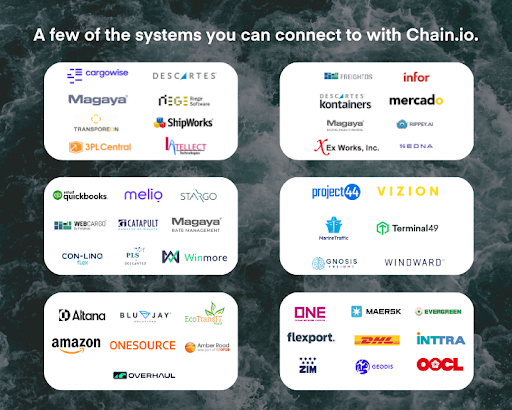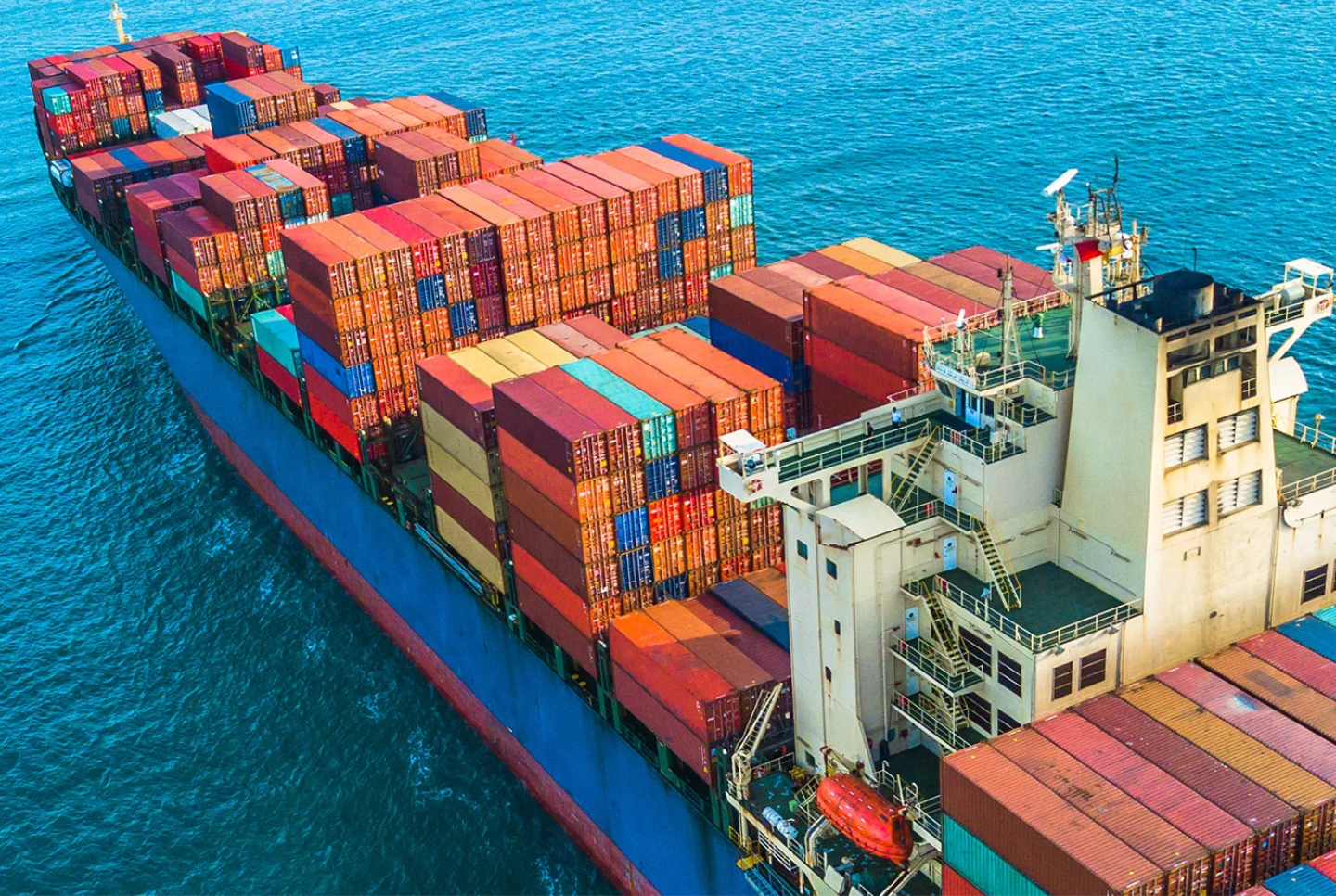
In the fast-paced and intricate world of international supply chains, freight forwarders play a vital role in ensuring the seamless movement of goods from point A to point B. In fact, the global freight forwarding market grew from $191.01 billion in 2022 to $199.09 billion in 2023 at a compound annual growth rate (CAGR) of 4.2% and is expected to grow to $224.78 billion in 2027 at a CAGR of 3.1%.
Freight forwarders orchestrate the complex dance of transportation, documentation, and regulatory compliance, bridging the gaps between manufacturers, shippers, carriers, and consignees. However, as the supply chain landscape evolves and becomes increasingly interconnected, the need for integration and interoperability in freight forwarding systems has never been more critical.
In the complex world of freight forwarding, where multiple parties, technologies, and regulations converge, integration and interoperability are paramount. By breaking down data silos and enabling real-time collaboration, organizations can achieve heightened visibility, streamlined workflows, and improved decision-making capabilities.
Here, we’ll explore eight use cases that demonstrate how automation can revolutionize repetitive documentation and data workflows. Through the power of Chain.io's cutting-edge technology, these use cases provide a blueprint for streamlining operations and unlocking new productivity levels.
Use Cases for Automating Repetitive Documentation and Data Workflows
1. Supply Chain Visibility and Reporting
One of freight forwarders' biggest challenges is the need for more comprehensive visibility into their day-to-day operations. Often, critical data is spread across multiple systems, making it difficult to gather accurate insights and make informed decisions. However, freight forwarders can achieve real-time visibility and obtain reliable insights by automating data collection and reporting processes.
Automated systems can seamlessly capture and consolidate data from various sources, providing a holistic view of the supply chain. With accurate and timely reporting, organizations can identify bottlenecks, track performance metrics, and optimize operations, ultimately enhancing decision-making and operational efficiency.
2. Integration of Logistics Technology
Freight forwarders often rely on multiple best-in-class logistics applications to manage different aspects of their operations. However, the lack of seamless data flow and integration between these systems can lead to inefficiencies and data discrepancies. Automation offers a solution by simplifying the integration process.
Automated workflows can enable the smooth transfer of data between various applications, eliminating the need for manual data entry or complex data transformations. By streamlining system integration, automation improves operational efficiency, reduces errors, and allows organizations to leverage the full potential of their logistics applications.
3. Invoicing and Payment Processing
Traditional invoicing and payment processing methods can be time-consuming and impact cash flow. Manual tasks such as generating invoices, sending them to customers, and handling paper checks or complicated ACH settlements can lead to delays and inefficiencies.
Automation provides a solution by streamlining the invoicing and payment processes. Automated systems can generate and send invoices electronically, eliminating manual intervention and reducing errors. Furthermore, automation can facilitate seamless payment processing by integrating with electronic payment platforms, accelerating payment cycles, and improving financial management.
4. Freight Forwarding Management
Managing the intricacies of freight forwarding, particularly on the origin or destination side, can be a costly and time-consuming endeavor. Manual processes for tasks such as shipment tracking, documentation, and customs clearance can lead to delays, errors, and increased operational costs.
Automated systems can handle shipment tracking in real-time, generate accurate documentation, and expedite customs clearance processes. By reducing manual effort and streamlining workflows, automation improves operational efficiency, saves time, and prevents shipment delays.
5. Carrier Connectivity
Efficient coordination with carriers is crucial for smooth freight operations. However, establishing and maintaining direct connectivity with carriers can be challenging due to varying systems and protocols.
Automation is pivotal in improving carrier connectivity by facilitating automated communication and data exchange. Automated systems can integrate with carrier platforms, enabling seamless information exchange, tracking updates, and coordination of shipments. With enhanced carrier connectivity, organizations can streamline operations, improve collaboration, and achieve greater visibility and control over their supply chain.
6. Order Management
Order management can be complex, especially when dealing with multiple shippers and suppliers. Placing orders and estimating delivery times becomes challenging without accurate visibility into shipper and supplier details.
Automation simplifies order management by automating order creation, status updates, and delivery tracking processes. Organizations can streamline order processing, improve accuracy, and enhance customer satisfaction by centralizing and automating these tasks.
7. Inventory Management
Efficient inventory management is crucial for providing quality distribution services. However, manual inventory tracking and management can lead to inaccuracies, stockouts, and delays. Automation revolutionizes inventory management by providing accurate and up-to-date inventory records in real time.
Automated systems can track inventory levels, monitor stock movements, and generate automatic alerts for replenishment. With automated inventory management, organizations can optimize warehouse operations, reduce stockouts, and improve distribution services.
8. Compliance Management
Ensuring compliance with regulations and avoiding delays in the release of goods is essential for freight forwarders. However, manual compliance checks and documentation processes can be time-consuming and prone to errors.
Automation expedites compliance management by automating compliance checks and generating accurate documentation. Automated systems can integrate with regulatory databases, validate data, and automatically create compliance documents. By automating compliance management, organizations can accelerate the release of goods, enhance customer satisfaction, and reduce the risk of regulatory non-compliance.
Incorporating automation into these use cases empowers freight forwarders to overcome manual process challenges, streamline workflows, and elevate operational efficiency. By embracing automation and leveraging the capabilities of platforms like Chain.io, organizations can achieve seamless integration, data accuracy, and improved visibility throughout the supply chain. Automation catalyzes growth, enabling freight forwarders to optimize operations and stay ahead in a rapidly evolving industry.
Explore SolutionsThe Importance of Integration and Interoperability in Freight Forwarding Systems
Integration and interoperability have emerged as crucial factors in the success of modern freight forwarding systems. In this context, integration refers to the seamless connection and synchronization of disparate systems, platforms, and stakeholders involved in the supply chain. Interoperability, on the other hand, pertains to the ability of these interconnected entities to exchange and interpret data efficiently.
- Successful integration in freight operations brings forth a myriad of benefits. First and foremost, it eliminates manual data entry and repetitive documentation tasks, freeing up valuable time and resources for more strategic endeavors. Integration facilitates data from different systems (TMS, WMS, FMS) to be leveraged via a single platform or service, reducing manual errors. By automating these workflows, organizations can reduce errors, improve accuracy, and enhance overall operational efficiency.
- Furthermore, integration and interoperability foster better communication and collaboration among stakeholders. With seamless data exchange and synchronized systems, freight forwarders can ensure that everyone involved in the supply chain is on the same page. This leads to fewer delays, reduced miscommunication, and improved customer satisfaction.
- Another critical impact of successful integration is enhanced transparency. By consolidating data from various sources into a unified view, freight forwarders gain valuable insights into their operations, enabling proactive decision-making and facilitating agile responses to disruptions or changes in the supply chain. Real-time tracking of shipments, inventory levels, and delivery statuses becomes achievable, empowering organizations to optimize routes, anticipate bottlenecks, and meet customer expectations with greater precision.
Integration and interoperability are indispensable elements for freight forwarding organizations striving for efficiency, cost reduction, and enhanced supply chain transparency. By embracing these principles and leveraging advanced technologies, such as those offered by Chain.io, companies can unlock new levels of automation, collaboration, and performance in their operations.
Chain.io for ForwardersThe Challenges of Manual Processes in Freight Forwarding
While the freight forwarding segment is evolving rapidly, many organizations still rely on manual processes for critical documentation and data workflows. Unfortunately, these manual processes pose significant challenges that hinder operational efficiency and profitability. Here are a few challenges freight forwarders face due to manual processes:
- High Risk of Errors: One of the primary challenges freight forwarders face due to manual processes is the high risk of errors and inconsistencies. Manual data entry is susceptible to human error, resulting in incorrect information being recorded or transmitted. Such errors can lead to delays, shipment discrepancies, and regulatory compliance issues, negatively impacting overall freight operations and customer satisfaction.
- Time & Resource Intensive Processes: Freight forwarders are often burdened with repetitive tasks such as re-keying data, generating paperwork, and manually updating multiple systems. These labor-intensive activities consume valuable time and divert resources away from more strategic activities that drive growth and innovation.
- Lack of Real-Time Visibility: The absence of automated data capture and synchronization makes it challenging to track shipments, monitor inventory levels, and provide accurate status updates to customers. As a result, delays and disruptions in the supply chain are difficult to identify and address promptly, leading to decreased operational agility and potential revenue losses.
Manual processes present significant challenges for freight forwarders, affecting their overall operational efficiency and profitability. Adopting automation solutions provides a transformative path forward, empowering organizations to overcome these challenges and unlock the full potential of their freight operations.
The Power of Automation in Freight Forwarding
The freight forwarding industry addresses these challenges by turning to automation. By leveraging advanced technologies and integrating systems, automation streamlines repetitive documentation and data workflows, significantly reducing manual data entry issues. Automation and integration solutions, such as those offered by Chain.io, help freight forwarders cut costs, eliminate errors, and enhance overall operational efficiency.
- One of the key benefits of automation is the significant reduction in manual labor and data entry. Automated systems can extract, process, and exchange data seamlessly, eliminating the need for time-consuming manual input and reducing the risk of errors. This allows freight forwarders to allocate resources strategically and focus on value-added activities.
- Automation also enhances visibility and transparency in freight operations. Real-time tracking and monitoring of shipments, inventory, and documentation enable proactive decision-making, improved customer service, and faster issue resolution. Accessing accurate and up-to-date information empowers freight forwarders to make data-driven decisions, optimize routes, and mitigate potential disruptions effectively.
- Moreover, automation facilitates better collaboration and communication among stakeholders. Automation enables seamless information exchange between customers, vendors, partners, and internal teams by integrating systems and sharing data in a standardized format. This fosters stronger partnerships, enhances supply chain visibility, and streamlines processes throughout the freight forwarding ecosystem.
- Additionally, automation brings scalability and agility to freight operations. With automated workflows, organizations can handle increased volumes of transactions without compromising accuracy or speed. This scalability allows freight forwarders to adapt to changing market demands, seize new opportunities, and stay competitive in a rapidly evolving industry.
Automation accelerates data processing and communication and improves accuracy by minimizing human intervention. It enables seamless data integration across various platforms and systems, enabling real-time visibility and comprehensive traceability throughout the supply chain. With automation, freight forwarders can optimize resource allocation, improve collaboration with partners, and swiftly make data-driven decisions.
Why Freight Forwarders Need to Leverage Supply Chain Integration Systems
Implementing automation in freight forwarding will help revolutionize operations and drive success in the global supply chain. From supply chain visibility and reporting to compliance management, automation streamlines processes, enhances visibility, improves collaboration, and increases operational efficiency. By eliminating manual tasks, reducing errors, and providing real-time insights, automation empowers organizations to make data-driven decisions, optimize resources, and deliver exceptional customer experiences.
In today's fast-paced and highly competitive business landscape, embracing digital transformation is no longer an option but a necessity. Organizations must proactively adopt automation and leverage advanced technologies to overcome challenges, streamline workflows, and unlock new opportunities to stay ahead in the freight forwarding industry.
Therefore, freight forwarders must assess their current processes, identify areas where automation can significantly impact, and seek out trusted partners like Chain.io to implement tailored automation solutions. By integrating systems, connecting stakeholders, and automating repetitive tasks, freight forwarders can achieve seamless operations, elevate supply chain visibility, and drive revenue and customer satisfaction growth.

Leverage Chain.io, an innovative supply chain and logistics systems integration platform revolutionizing how organizations connect and collaborate. With supply chain best practices baked in, Chain.io enables freight forwarders to amplify their efficiency, cut costs, and elevate supply chain visibility. Seamlessly integrating partners across the global supply chain empowers logistics companies to create cohesive workflows with customers, vendors, partners, and internal systems.
Chain.io is natively integrated into the industry's leading technology platforms. With our pluggable component architecture, you can assemble integrations between your internal systems, the latest SaaS platforms, your customer's legacy systems, and more.
Check out some of our pre-built integrations or explore the product page for more details.
View IntegrationsExplore the Product


